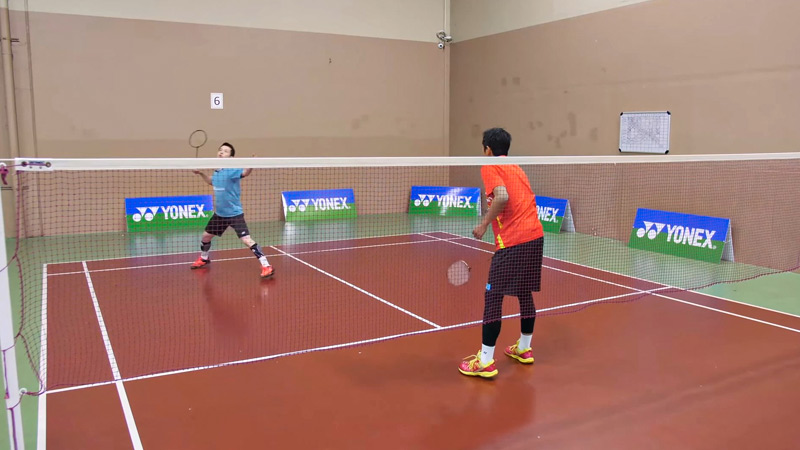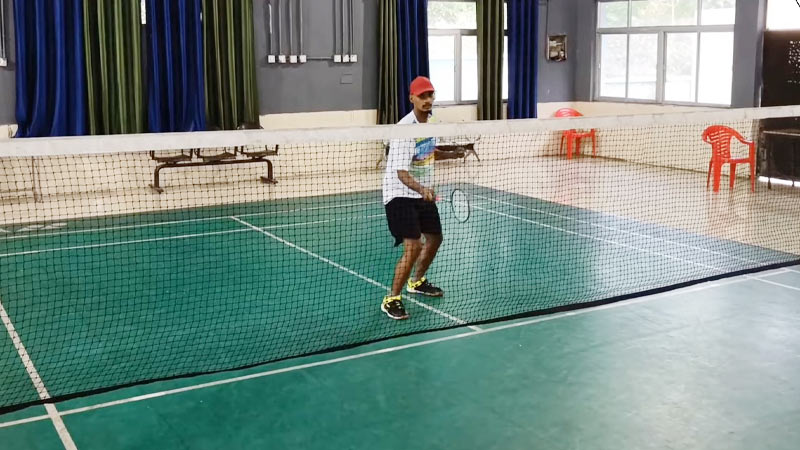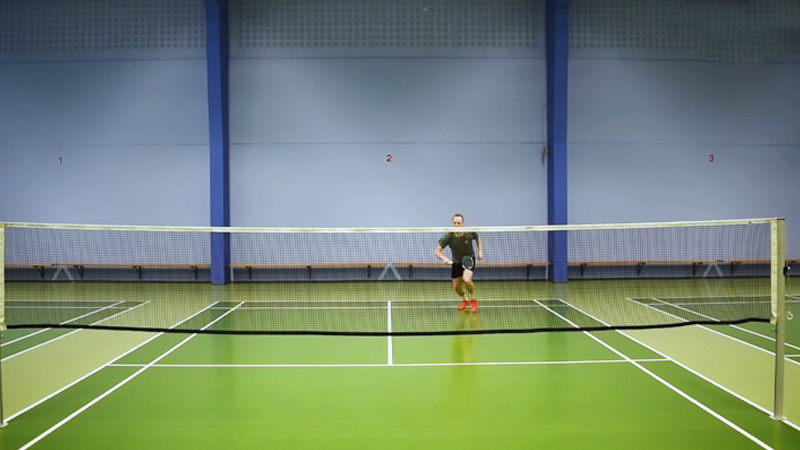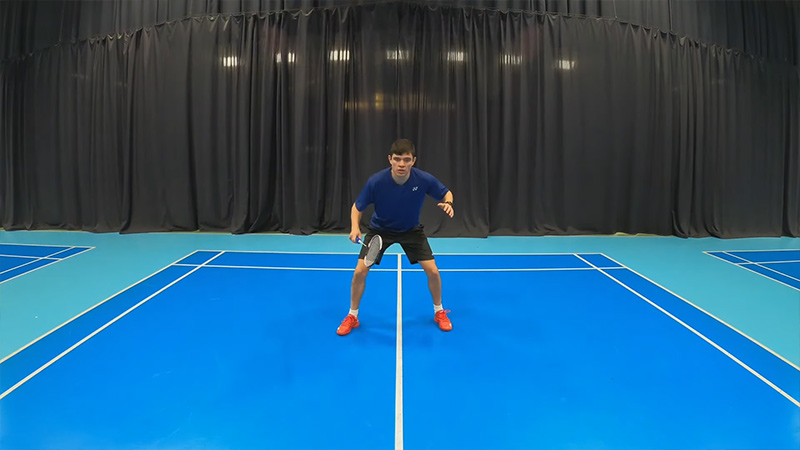Mastering badminton footwork is akin to dancing across the court, and the six-corner footwork technique is its choreography. In the game of badminton, agility, speed, and strategic court coverage are paramount.
So, what is six-corner footwork in badminton? The six-point footwork method is fundamental, involving movements to the front left, front right, mid-left, mid-right, rear left, and rear right corners.
It’s the foundation for efficient court navigation, enabling players to swiftly reach any area and respond to opponents’ shots with precision.
This technique demands not only physical agility but also mental alertness, requiring players to anticipate their opponent’s moves.
By understanding and honing the intricacies of the six-corner footwork, players can enhance their overall game, mastering the art of fluid movement and strategic positioning on the court. So, stay focused.
What Is Six Corner Footwork in Badminton?
Six-corner footwork in badminton refers to the movement pattern covering six key positions on the court. It’s a fundamental technique used to efficiently navigate and cover the playing area.
The footwork involves movements to the corners of the court: front left, front right, mid-left, mid-right, rear left, and rear right.
By mastering this footwork, players can swiftly reach any corner, enabling quick returns and maintaining strategic positioning during a rally.
It’s crucial for players to develop agility, speed, and balance to execute these movements effectively.
This footwork technique not only aids in covering the court but also contributes to a player’s overall performance, enabling quicker responses to opponents’ shots and better court coverage.
Basics of 6 Corner Footwork in Badminton
Mastering the six-corner footwork in badminton is foundational for agility and court coverage. Here are the fundamental aspects of this footwork technique:
Central Base and Movement Initiation
The starting point is crucial. The central base position serves as the launching pad for movements to any corner.
Players must initiate footwork from this central position to efficiently cover the front left, front right, mid-left, mid-right, rear left, and rear right corners.
Developing a strong sense of starting from and returning to this central position is key.
Different Movement Dynamics
Each corner demands distinct footwork dynamics. Front corners often require quick, short steps to ensure rapid coverage.
In contrast, moving to rear corners might involve longer strides or lunges to cover the greater distance efficiently. Adapting footwork to suit the demands of each corner optimizes movement.
Transitional Fluidity and Quick Recovery
Fluid transition between these corners is crucial. Players should strive for seamless movement, ensuring that no corner is neglected.
Moreover, the ability to recover swiftly to the central base position after each shot or movement is essential. This quick recovery ensures readiness for the opponent’s next play.
Strategic Positioning and Anticipation
Footwork isn’t just about reactive movements but also strategic positioning. Anticipation of the opponent’s shots and positioning oneself accordingly is vital.
This proactive approach enables players to cover corners more effectively, leading to better shot placement and quicker returns.
Balance, Control, and Endurance
Beyond speed, balance, control, and endurance play pivotal roles. Maintaining a low, balanced stance allows for quick changes in direction while minimizing the risk of losing balance.
Building endurance through consistent practice ensures sustained agility throughout a game or match.
Breakdown of 6 Basic Footwork in Badminton

A breakdown of the six basic footwork movements in badminton:
Base Position and Readiness
Start with a balanced base position, feet shoulder-width apart, and knees slightly bent.
This position allows for quick and agile movements in any direction. Being on the balls of your feet ensures readiness to react swiftly.
Front Court Movements
To cover the front left and front right corners, the footwork involves a combination of small, quick steps.
For the front left corner, initiate with a push from your back foot to move towards that area. For the front right corner, use a similar approach but in the opposite direction.
Mid-Court Maneuvers
Moving to the mid-left and mid-right corners necessitates lateral shuffling with quick, precise steps.
Shift your weight from one foot to the other while maintaining a low stance to cover these areas efficiently.
Rear Court Transitions
To cover the rear left and rear right corners, longer strides or lunges might be required.
Moving to these corners involves a combination of larger steps or lunges, allowing you to reach farther distances while maintaining balance and control.
Transition and Recovery
The key is to smoothly transition between these corners while always returning to the central base position after each shot.
This helps in maintaining control, balance, and readiness for the next move, ensuring you’re prepared for any shot your opponent plays.
Proper recovery to the base position is essential for effective court coverage.
Common Mistakes to Avoid Regarding 6 Footwork in Badminton

Mastering footwork in badminton is crucial for maneuvering the court effectively. Here are common mistakes to avoid when practicing the six-foot movement:
Neglecting Recovery to Base
Often, players overlook the significance of returning to the central base position after each shot.
Neglecting this recentering can compromise readiness for the next move, leading to slower reactions and limited court coverage. Always return to the base to maintain control and readiness.
Inadequate Weight Transfer
Incorrect weight transfer can impede movement efficiency. Shifting weight incorrectly while transitioning between corners hampers speed and agility.
Ensure smooth weight transfer, pushing off from the correct foot to move swiftly to the desired corner.
Poor Balance and Stance
A common mistake is maintaining an incorrect stance or losing balance during movements.
Keeping a low, balanced stance is crucial for stability and quick responses. Losing balance often results in slower movements and compromised shot accuracy.
Limited Footwork Variation
Some players tend to use one type of footwork for all corners. However, different corners demand varied footwork techniques.
For instance, front corners require short, quick steps, while rear corners may need larger strides. Failing to adapt footwork to specific corners limits efficiency and speed.
Ignoring Practice and Drill Sessions
Regular practice and drills focusing on footwork are essential. Ignoring dedicated sessions to improve footwork can limit a player’s overall agility and court coverage.
Consistent practice hones the necessary skills for efficient movement across all corners of the court.
Drills and Exercises for Badminton 6 Point Footwork

Improving footwork in badminton necessitates dedicated drills and exercises tailored to the six-point footwork technique. Here are some effective drills to enhance this crucial skill:
Corner-to-Corner Shuttle Runs
Create a drill focusing on moving swiftly between the six corners of the court. Start from the central base and move to each corner in sequence, utilizing the specific footwork required for each.
Incorporate shuttle runs that mimic the movement dynamics needed for the front, mid, and rear corners. This drill enhances speed, agility, and precision in covering the court.
Shadow Footwork Practice
Utilize shadow footwork exercises, which involve moving through footwork patterns without a shuttle or opponent.
This allows players to focus solely on the technique, ensuring proper weight transfer, foot positioning, and balance. It’s an effective way to reinforce muscle memory for the six-point footwork.
Interval Training for Endurance
Integrate interval training to improve endurance and sustained footwork performance.
Design sessions that alternate between high-intensity bursts of six-point footwork movements and periods of rest or lower activity.
This type of training enhances not only footwork but also stamina, enabling players to maintain agility throughout a match.
Reaction-Based Drills
Incorporate drills focusing on quick reactions and transitions. For instance, have a partner or coach randomly hit shuttles to different corners, requiring you to react swiftly and move to the corresponding corner.
This drill hones reflexes, decision-making, and the ability to adjust footwork based on the opponent’s shots.
Footwork Circuit Training
Set up a circuit with stations at each of the six corners. Perform specific footwork techniques or movements at each station before moving to the next.
This circuit-based training allows players to work on the footwork for each corner in succession, promoting seamless transitions and enhancing overall court coverage.
Consistent practice of these drills helps players improve their footwork, making them more agile and efficient in covering the entire badminton court.
FAQs
6-point footwork in badminton?
The 6-point footwork in badminton refers to the strategic positioning and movement across six key areas on the court.
These points cover the corners and midcourt areas where players need to move swiftly to cover the court effectively. It’s an essential technique to maintain court coverage and respond to various shots efficiently.
6 corners footwork in badminton?
The 6 corners footwork in badminton focuses on maneuvering across the six key areas or corners of the badminton court.
Players need to cover these corners swiftly, adjusting their positioning to respond to shots effectively.
It’s a fundamental skill, ensuring players can reach and return shots from any corner swiftly.
What are the types of footwork in badminton?
In badminton, footwork comprises various techniques, including basic, defensive, offensive, and transitional footwork.
These techniques involve movements like the side shuffle, scissor jump, chasse step, split step, and lunge. Each type serves different purposes, aiding players in reaching and responding to shots effectively.
Is footwork badminton good?
Good footwork in badminton is essential for success. It enables players to swiftly cover the court, maintain balance, and respond effectively to opponents’ shots.
Excellent footwork involves agility, speed, and precise positioning, allowing players to reach every corner of the court efficiently.
What is the badminton 6 corners footwork?
The badminton 6 corners footwork refers to the strategic movement across the six key areas of the court: the four corners and the midcourt areas.
Players use this footwork technique to cover these zones effectively, ensuring they can respond to shots from any part of the court, optimizing their gameplay.
Wrapping Up
In the world of badminton, mastery of footwork is a game-changer. The six-corner footwork technique is the backbone of court coverage, enhancing a player’s ability to swiftly respond and strategically position themselves.
By perfecting this fundamental skill, players not only increase their agility and speed but also gain a competitive edge.
The seamless transitions between the six corners of the court become second nature, enabling players to anticipate and counter their opponents’ moves effectively.
Whether it’s swift movements to the front corners or agile strides to the rear, this technique refines a player’s overall game, making them a more formidable force on the court.
Mastering the art of the six-point footwork is the key to becoming a dynamic and agile player in the world of badminton. Best wishes.







